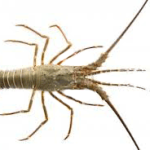
Abalones are slow growing, herbivorous marine snails. They belong to a large class of molluscs (Gastropoda) with singlestructured shells. There are over 100 species worldwide in the single genus Haliotis, which means ‘sea ear’, a reflection of the flattened shape of the shell. It is no surprise then that it is called ‘Oreille de Mer’ in France. Abalone shells can be oval or rounded, with a row of respiratory pores and large dome towards one end.
The strong, muscular foot generates enough suction to allow the abalone to fix itself firmly to rocky surfaces. They are found from the intertidal to the depth limit of marine plants, some 80 -100m, and from tropical to cold waters.
Abalone is an edible mollusc and considered a delicacy. They are found along the rocky shores of Australia, south from mid New South Wales down and around to Western Australia.
There are eleven abalone species to be found in the waters of Western Australia. Three of these are commercially fished from reefs off the coast.
The most common species is Roe’s abalone (Haliotis roei), which is found on reef platforms along the western and southern coasts. The greenlip abalone (Haliotis laevigata), and brownlip abalone (Haliotis conicopora), are larger, less common and as a result are more valuable. These species are found mainly on the southern coasts.








Social Profiles